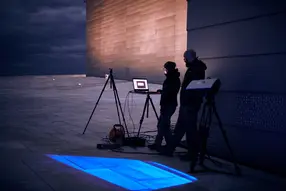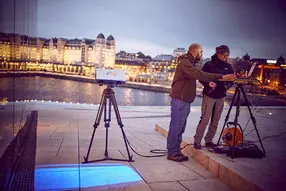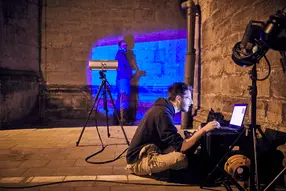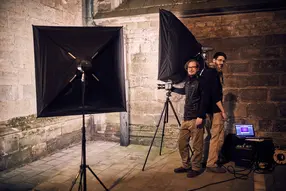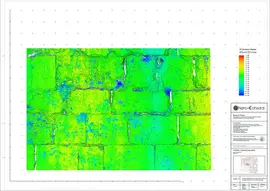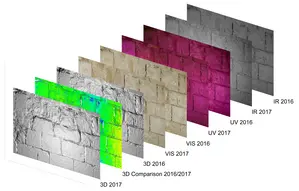Nano-Cathedral
Content and aims
The Nano-Cathedral project facilitated an international collaboration of institutions, universities and cathedral builders in six European countries with the aim of developing and testing new, tailor-made strengthening and hydrophobizing agents based on nanotechnology for the preservation of weathered stone. In addition to broad-based experiments in the laboratory, limited areas at five outstanding historic cathedrals (Ghent, Cologne, Pisa, Vitoria-Gasteiz and Vienna) and at the modern Oslo Opera House served as test sites. These were different rock types (limestone, sandstone and marble) in different climatic areas with different weathering processes. The University of Bamberg participated in the Nano-Cathedral project with two very different expertises. First, a refined monitoring system using photographic methods was applied to map, document and monitor the test surfaces at the churches and the Oslo Opera House throughout the test phases. Changes on the stone surface could be visualized in this way and also provided information about the effectiveness of the new nanoproducts applied.
In contrast to conventional methods, no sample material was required here for investigations. On the other hand, the expertise of the Bamberg Center for Empirical Studies (BACES) was required to investigate the economic, social and cultural effects of the introduction of the newly developed nanobased protection and strengthening agents. For this purpose, different target groups such as producers of stone preservatives, users of such products and also the general population were interviewed.
Official website: www.nanocathedral.eu
Methodology
Monitoring
Monitoring combines five analytical methods, all of which are NDTs (Non-Destructive-Testing Methods). They are also imaging methods. With the aid of photogrammetry, the various result images are superimposed without distortion and merged into a CAD plan. UV fluorescence photography was used, VIS photography (color photography), infrared reflectography, 3D scanning and 3D surface comparisons. Within the project two monitoring campaigns could be realized. With the first campaign in April / May 2016, the initial condition of the test surfaces was documented. The documentation served the restorers of the participating cathedral construction huts as a basis for detailed preliminary examinations. Damage phenomena as well as surface details such as paint residues could be easily differentiated, characterized and mapped on the plans. Using this information, conservators were able to determine preparatory measures prior to treatment with new products. In some cases, the surfaces only required cleaning with distilled water. Other test surfaces were covered with black crusts, requiring cleaning with microparticle blasters. After the preparatory measures were completed, the test areas were treated with the newly developed consolidation and hydrophobizing agents in the summer of 2017.
Subsequently the second monitoring campaign was conducted in October/November 2017. By comparing the two campaigns, surface changes due to one year of weathering as well as the cleaning measures and the treatment with the new materials can be detected and visualized. The 3D comparison shows surface changes of up to 20 mm. In the VIS image, on the other hand, it is difficult to detect surface loss, but possible color changes due to the applied materials can be easily detected. Some of the materials used are visible in the UV fluorescence image. This is therefore a suitable method to document the weathering behavior of UV-active preservatives, while the growth of algae, lichens and crusts can be detected using IR reflectography. Overlaying the different techniques in a common plan can increase the value of surface observation and analysis significantly, and changes between multiple monitoring campaigns can be directly compared.
Studies of economic, social, and cultural effects
BACES has focused on the study of social impacts, with significant contributions to all issues. In the analysis of economic impacts, mainly Italian partners were involved, and in the analysis of cultural impacts, mainly Austrian partners.
Among other things, BACES conducted a broadly representative survey of the populations in the project countries to gauge the acceptance of new technologies and nanotechnology in particular. In individual interviews, representatives of the relevant producers of stone preservation products were asked about their assessments of the potential of nanobased stone treatment agents. Finally, users of strengthening and protective agents were also asked about their expectations and reservations regarding the newly developed agents. This was done in several workshops and particularly intensively in group discussions with the stonemasons and restorers of the K?lner cathedral building lodge.
The economic consequences of the introduction of new nano-based stone preservation products can be seen at various levels, as a market analysis among producers shows. The market for tailor-made strengthening and protective agents for stone conservation is thus not limited to the field of monument conservation but also to new buildings. Nanotechnology is not a major challenge for most producers, as nanomaterials are already being used in some cases, investments are being made steadily, and the existing strict occupational health and safety laws are sufficient for protection during production. The population surveys showed a high degree of openness to new technologies in all the countries surveyed, with the majority rating them as particularly important for the development of their countries. Respondents generally considered themselves to be more technology-friendly than society as a whole. The greater the knowledge, about nanotechnology the higher was the acceptance. Overall, it can be concluded that the use of nanobased stone treatment agents would currently be assessed by the population as largely unproblematic. The respondents in the countries surveyed considered the preservation of cultural assets and monuments to be an important social task. In their opinion, the preservation of monuments should also be supported with public funds. However, significantly more respondents in Spain and Italy rated this aspect as more important than in Germany, Austria or even Norway. There is agreement that the protection and preservation of monuments strengthens the cultural identity of the population and promotes tourism. A large majority prefers renovated and cleaned facades. It is noteworthy that good condition in modern monuments promoted perceived attractiveness to an even greater extent. The use of modern protective agents for stone conservation is generally favored.
Among restorers and stonemasons, assessments of the usefulness of new strengthening and protective agents were more reserved, based on their experience. There were doubts whether new agents have a strong added value compared to conventional agents, even if the currently available agents are not always satisfactory. Another role was played by the bad experiences in the past with numerous innovations and agents that did not meet the expectations placed in them or even damaged the architectural monuments. Nevertheless, the users were open to innovations and showed interest in nanotechnology and its use in the field of monument protection. Already in the past decades, the field of work of the restorers and stonemasons has changed for the better with the introduction of various new techniques, tools and means.
Outlook
The Nano-Cathedral project has ushered in a new phase in the treatment of architectural monuments. In the field of strengthening agents, nanotechnology has made it possible to significantly improve bonding to mineral grain surfaces, achieve more efficient bridging, and achieve lower shrinkage than silicic acid esters. The advantage of the new products is considered to be their combinability with conventional strengthening agents. However, it is still too early for a final evaluation. It is planned to continue monitoring after the end of the project in order to test the long-term effect of the stone preservation products.
Current publication
Rahrig, Max / Drewello, Rainer / Lazzeri, Andrea: Opto-Technical Monitoring – A standardized methodology to assess the treatment of historical stone surfaces, in: Int. Arch. Photogramm. Remote Sens. Spatial Inf. Sci., XLII-2, 945–952 (https://doi.org/10.5194/isprs-archives-XLII-2-945-2018).
Pictures
Click on the images to enlarge.

